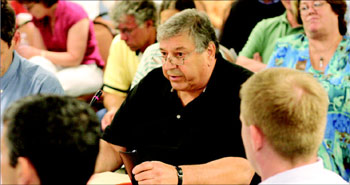Groundfish Plunges
Science Questioned
by Laurie Schreiber
|
PORTLAND, ME - New numbers show that overall groundfish stock rebuilding isn’t working.
Measures of stock status in a presentation on the latest groundfish assessment, which has not been completed yet, are “provisional, preliminary, uncertain, subject to change” and “are provided simply as a way of gauging general trends,” Northeast Fisheries Science Center scientist Paul Rago told the New England Fishery Management Council at their June meeting in Portland. The finalized assessment, which comes from the third Groundfish Assessment Review Meeting, is expected to be out in September.
Despite the preliminary nature of the numbers, said Rago, the trend is pointing downward.
The preliminary results of GARM III, a regional peer-review process which allows NEFMC to gauge progress toward rebuilding fish stocks, indicate that many flounder stocks will require much more of a management focus than previously assumed, Rago said.
Of equal concern was information pointing to a reduction in the overall productivity of the ecosystem, a finding that will affect NEFMC’s rebuilding programs in ways that are not yet clear.
This information, uncertain though it may be, drove NEFMC to delay development of Amendment 16 to the groundfish management plan. A new timeline was drawn up that will enable NEFMC to respond to the GARM report in the fall.
continue
|

Vito Calomo of the Northeast Seafood Coalition, Gloucester. “We have restrictions and more restrictions, and no balance for the fishing industry. We need to think about the communities. This is the worst time I’ve seen in my 64 years of living. This is a disastrous time,” said Calomo at the Council meeting in Portland June 4, in response to Dr. Paul Rago’s comments on the stock assessment. Sam Murfitt photo |
|
|
|
|
Last Of The Bankers
by Mike Crowe
|
The schooners that fished off shore in New England after the Civil War became the most productive sail-powered fleet in American history by the turn of the century. They also very likely represented the peak of production for hand line fishing in human history.
The banks schooners and Grand Bankers, which fished the Grand Banks off Newfoundland, are a major part of the fishing, commercial, and economic history of the Northeast. The large numbers of these schooners built over decades, the many fishermen who fished from them, the many shipyards that built them, the great prosperity they brought ashore and the colossal tragedy wrought when a storm sent many to the bottom on the banks, is what has embedded them in the popular imagination of the nation.
These two-masted schooners, about 100 feet in length, contributed to bringing commercial fishing in New England to it’s greatest height at the turn of the 20th century. Many of the builders of Maine and Massachusetts built them. In the latter part of the 1800’s fishing on the banks was done using hand-line trawls set from dories. Schooners were built to take dories and fishermen out to Georges or the Grand Banks to fish until the schooner was full or they ran out of food and water.
Schooners had long been the mainstay of coastal shipping and fishing. The New England fishing boom brought in designers who sought speed and great looks for owners. One, Edward Burgess, the son of a wealthy Boston merchant whose “good life” in European salons ended abruptly when his father suddenly died broke. Burgess returned to Boston and began designing yachts. He moved into commercial vessel design for the banks fishing industry.
continue
|
| The Effie M. Morrissey was one of hundreds of banks schooners built in the last half of the 19th century. Reamed the Ernestina in 1948, it is the only surviving operational Fredonia type. The 100' to 120' schooners werer the back bone of the fishing industry in the northeast until the 1920s. Photo Courtesy of Schooner Ernistina Commission |
|
|

